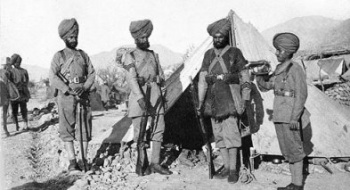Template:AOW50: Difference between revisions
From SikhiWiki
Jump to navigationJump to search
Hari singh (talk | contribs) No edit summary |
Hari singh (talk | contribs) No edit summary |
||
| (One intermediate revision by the same user not shown) | |||
| Line 11: | Line 11: | ||
[[Guru Gobind Singh|by Sri Guru Gobind Singh]] - [[Sikh Regiment|the motto of the Sikh Regiment]]<br> | [[Guru Gobind Singh|by Sri Guru Gobind Singh]] - [[Sikh Regiment|the motto of the Sikh Regiment]]<br> | ||
<div align=right>('''[[Deh Shiva Bar Mohe Eha]]''')</div> | <div align=right>('''[[Deh Shiva Bar Mohe Eha]]''')</div> | ||
</small></blockquote> | </small></blockquote><!------------ | ||
'''Saragarhi''' is the incredible story of 21 men of the 4<sup>th</sup> [[Sikh Regiment]] (previously the 36<sup>th</sup> Sikh Regiment) who gave up their lives in devotion to their duty. The 36th Sikh Regiment was raised at Jalandhar on '''April 1887''' under the command of Colonel Cook. The famous battle, like many others fought by the Sikhs, highlights the heroic action by a small detachment of [[Sikh]] soldiers against heavy odds. | '''Saragarhi''' is the incredible story of 21 men of the 4<sup>th</sup> [[Sikh Regiment]] (previously the 36<sup>th</sup> Sikh Regiment) who gave up their lives in devotion to their duty. The 36th Sikh Regiment was raised at Jalandhar on '''April 1887''' under the command of Colonel Cook. The famous battle, like many others fought by the Sikhs, highlights the heroic action by a small detachment of [[Sikh]] soldiers against heavy odds. | ||
This encounter took place on '''12 September 1897''' in the {{wiki|Tirah}} region of {{Wiki|North-West Frontier Province}} (now in [[Pakistan]], which then formed part of {{wiki|British India}}). In keeping with the tradition of the [[Sikh Regiment|Sikh Army]], they fought to the death rather than surrender. The scenario is somewhat similar to the [[Battle of Chamkaur]] which was fought by {{G10}} in 1705. | This encounter took place on '''12 September 1897''' in the {{wiki|Tirah}} region of {{Wiki|North-West Frontier Province}} (now in [[Pakistan]], which then formed part of {{wiki|British India}}). In keeping with the tradition of the [[Sikh Regiment|Sikh Army]], they fought to the death rather than surrender. The scenario is somewhat similar to the [[Battle of Chamkaur]] which was fought by {{G10}} in 1705. The [[Battle at Saragarhi]] is one of eight stories of collective bravery published by {{wiki|UNESCO}} (United Nations Educational, Scientific and Cultural Organization). It has been mentioned as one of the five most significant events of its kind in the world which includes the {{wiki|Battle of Thermopylae}} associated with the heroic stand of a small Greek force against the mighty Persian Army of {{wiki|Xerxes I}} in 480 B.C.------> {{Aowf|Battle of Saragarhi}} | ||
Latest revision as of 11:03, 9 July 2010
On September 12, the Sikhs worldwide will remember with honor the supreme sacrifice of their brave comrades who for the security and safeguard of their country willingly laid down their lives. The bravery of these soldiers was inspired by the heart piercing message of their tenth Guru, Guru Gobind Singh.
O God, give me these boons
that never shall I shirk from doing good deeds
that never shall I fear when I go into battle
And that with surety I shall attain victory.
by Sri Guru Gobind Singh - the motto of the Sikh Regiment

